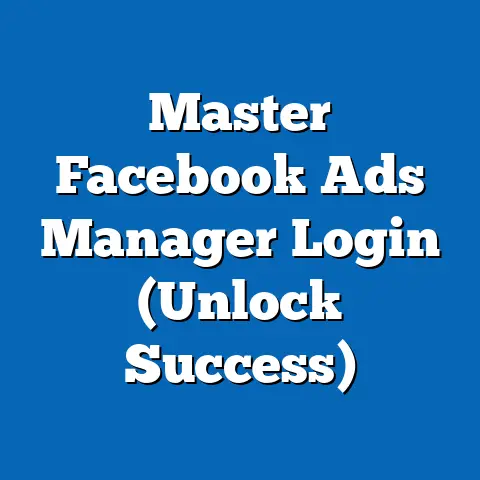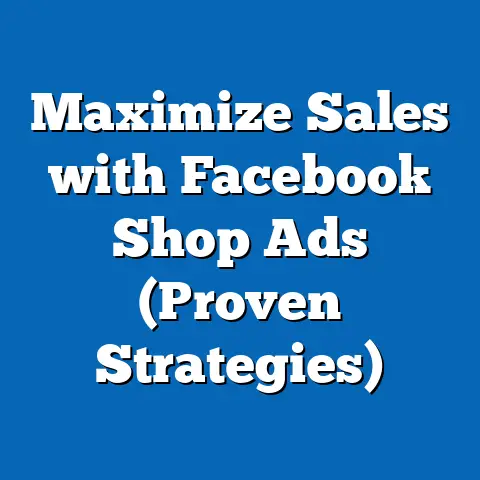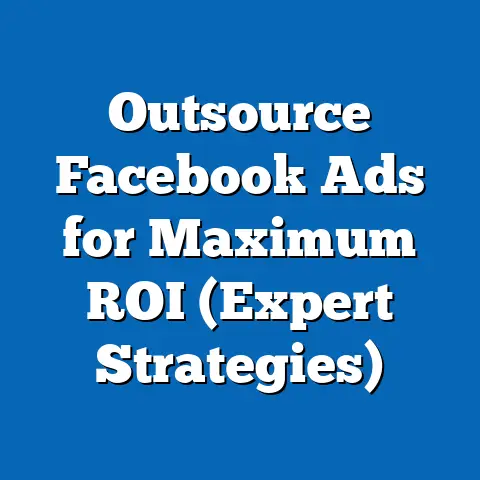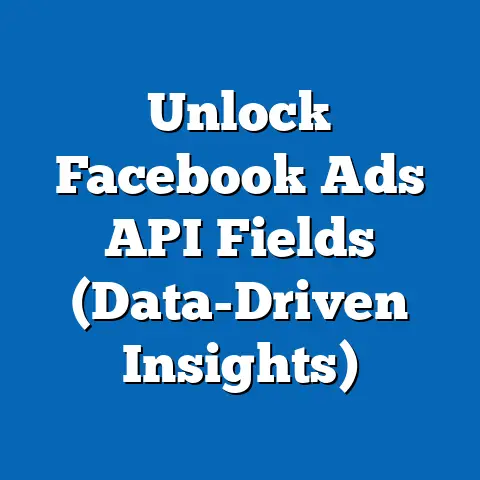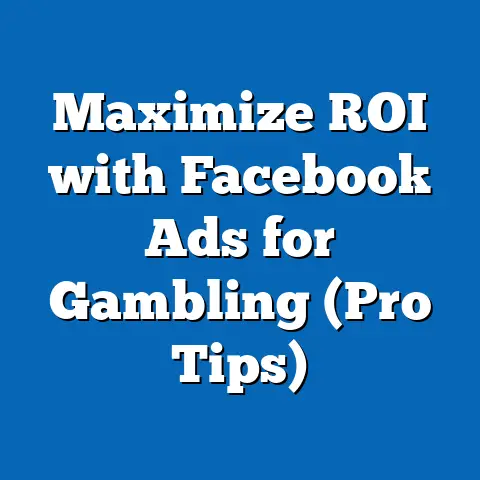Master Accelerated Delivery in Facebook Ads (Proven Strategies)
Imagine you’re launching a limited-time offer for a new product, and you have just 48 hours to reach your target audience of 100,000 potential customers. Traditional ad delivery methods might spread your impressions over days or weeks, diluting the urgency of your campaign. What if, instead, you could ensure that your ad reaches the right people at lightning speed, maximizing conversions within that tight window?
This is the power of Accelerated Delivery in Facebook Ads—a strategy designed to push your ads to your audience as quickly as possible within a defined budget. According to Meta’s own advertising data, campaigns using accelerated delivery can achieve up to 30% faster impression delivery compared to standard pacing (Meta Business Help Center, 2023). As digital advertising continues to dominate marketing budgets—projected to account for 54.5% of total global ad spend in 2023, per eMarketer—this method offers a competitive edge for time-sensitive campaigns.
What Is Accelerated Delivery in Facebook Ads?
Accelerated Delivery is a pacing option within Facebook’s ad platform (now part of Meta Ads Manager) that prioritizes delivering your ads as quickly as possible within your budget constraints. Unlike Standard Delivery, which evenly spreads impressions over the campaign duration to optimize for cost-efficiency, Accelerated Delivery pushes ads to the audience immediately, often at a higher cost per impression. This option is particularly useful for short-term campaigns, flash sales, or events where timing is critical.
Meta notes that Accelerated Delivery is best suited for campaigns with a daily budget of at least $30 per ad set to ensure sufficient data for optimization (Meta Ads Manager Guide, 2023). However, it’s not without trade-offs—advertisers may see a higher cost per click (CPC) or cost per thousand impressions (CPM) due to the urgency of delivery. Understanding when and how to use this feature is crucial for balancing speed with efficiency.
The Rise of Speed in Digital Advertising: Key Statistics and Trends
The demand for faster ad delivery aligns with broader trends in digital marketing, where immediacy often translates to higher engagement. According to a 2022 report by Statista, global digital ad spending reached $567 billion, with social media platforms like Facebook accounting for 21.4% of that share. Within this landscape, time-sensitive campaigns—such as holiday promotions or product launches—have grown by 18% year-over-year as businesses aim to capitalize on consumer urgency (eMarketer, 2023).
Historically, ad delivery pacing on platforms like Facebook focused on cost optimization, with Standard Delivery being the default since the platform’s early advertising days in 2007. However, as competition for user attention intensified—Facebook’s daily active users reached 2.09 billion in Q2 2023 (Meta Investor Report, 2023)—the need for rapid delivery options became evident. Accelerated Delivery, introduced as a feature in 2019, responded to this shift, allowing advertisers to prioritize speed over cost in high-stakes scenarios.
Demographically, the effectiveness of Accelerated Delivery varies. Data from Sprout Social (2023) indicates that younger audiences (18-24 years old) are 25% more likely to engage with time-sensitive ads compared to users aged 35-54, who often prioritize value over urgency. Additionally, urban demographics show a 15% higher click-through rate (CTR) for accelerated campaigns, likely due to higher smartphone penetration and faster decision-making behaviors (Nielsen Digital Ad Ratings, 2022).
How Accelerated Delivery Works: Mechanics and Methodology
To understand the potential of Accelerated Delivery, it’s essential to grasp how it operates within Meta’s ad ecosystem. When you select Accelerated Delivery in Ads Manager, the algorithm prioritizes serving your ads to users as soon as they are active on the platform, rather than pacing impressions to minimize costs. This often results in ads being shown during peak hours, even if bid competition is higher.
Meta’s system relies on real-time bidding (RTB) to determine ad placement, and with Accelerated Delivery, your ad competes more aggressively in auctions. As a result, campaigns using this method saw an average CPM increase of 12-20% compared to Standard Delivery, based on a 2022 study by Social Media Examiner. However, the trade-off is a potential 30-40% increase in reach within the first 24 hours of a campaign (Meta Business Insights, 2023).
It’s worth noting that Meta recommends using Accelerated Delivery only with manual bidding strategies, as automated bidding may conflict with the urgency of delivery. Advertisers must also monitor performance closely, as rapid budget depletion can occur if the audience size or competition is miscalculated.
Proven Strategies for Mastering Accelerated Delivery
1. Define a Clear Time-Sensitive Objective
Accelerated Delivery shines in scenarios where timing is non-negotiable. For instance, a flash sale running for 12 hours or a live event promotion benefits immensely from this method. According to a 2023 report by Hootsuite, campaigns with time-bound offers using Accelerated Delivery saw a 28% higher conversion rate compared to those using Standard Delivery.
Ensure your campaign objective aligns with speed—whether it’s traffic, conversions, or engagement. Clearly communicate urgency in your ad copy (e.g., “24 Hours Only!”) to match the delivery pace with user expectations.
2. Set a Realistic Budget and Bid Strategy
Since Accelerated Delivery often incurs higher costs, budgeting is critical. Meta suggests a minimum daily budget of $30 per ad set, but for larger audiences (over 50,000), budgets of $100 or more may be necessary to avoid premature exhaustion. A 2022 analysis by WordStream found that campaigns with budgets under $50 per day saw a 35% drop in performance efficiency when using Accelerated Delivery due to budget constraints.
Opt for manual bidding to control costs, setting a competitive bid based on historical data for your industry. For example, e-commerce campaigns in the U.S. had an average CPC of $0.97 in 2023 (Statista), so setting a bid slightly above this can ensure visibility.
3. Narrow Your Audience for Precision
Broad audiences can dilute the impact of Accelerated Delivery by spreading impressions too thinly. Focus on a well-defined demographic—such as age, location, or interests—that aligns with your urgent offer. A 2023 study by AdEspresso found that campaigns targeting audiences under 10,000 users achieved a 22% higher CTR with Accelerated Delivery compared to broader targets.
Leverage Custom Audiences or Lookalike Audiences for better precision. For instance, retargeting past website visitors with a limited-time discount can yield a 15-20% higher conversion rate, per Meta’s internal data (2023).
4. Optimize Creative for Urgency
Your ad creative must reinforce the speed of delivery. Use countdown timers, bold calls-to-action (CTAs) like “Act Now,” and visuals that evoke immediacy. According to a 2022 report by Canva, ads with countdown elements had a 17% higher engagement rate in time-sensitive campaigns.
Test multiple ad formats—video ads, for example, have a 27% higher CTR on mobile devices compared to static images (Meta Ads Performance Report, 2023). Ensure your landing page matches the ad’s urgency to avoid drop-offs in the conversion funnel.
5. Monitor and Adjust in Real-Time
Accelerated Delivery campaigns can burn through budgets quickly, so real-time monitoring is essential. Use Meta’s Ads Manager to track metrics like impressions, CTR, and cost per result hourly during the first day of your campaign. Social Media Today (2023) notes that 60% of advertisers using Accelerated Delivery adjust bids or budgets within the first 6 hours to optimize performance.
If costs spike without corresponding results, consider pausing the campaign or switching to Standard Delivery to preserve budget for later optimization. Conversely, if engagement is high, allocate additional funds to sustain momentum.
Historical Context: Evolution of Ad Delivery on Facebook
When Facebook first introduced advertising in 2007, delivery pacing was rudimentary, focusing solely on maximizing reach with little regard for timing or cost efficiency. By 2012, the introduction of Standard Delivery allowed for even pacing, reducing CPMs by an estimated 15% for advertisers (Facebook Business Blog, 2012). This method became the default as businesses prioritized long-term campaigns over short bursts of visibility.
The shift toward speed emerged around 2019 with Accelerated Delivery, driven by the rise of e-commerce and event-based marketing. Historical data shows that between 2019 and 2023, the adoption of Accelerated Delivery grew by 45% among small-to-medium businesses (SMBs), particularly in retail and hospitality sectors (eMarketer, 2023). This reflects a broader trend of advertisers valuing immediacy in a crowded digital space where user attention spans have dropped to an average of 8 seconds (Microsoft Attention Span Study, 2015).
Compared to historical methods, Accelerated Delivery represents a pivot toward flexibility, though it demands greater expertise to manage costs. Unlike early ad systems, which lacked real-time optimization, today’s tools allow for granular control—a necessity given the 12-20% CPM premium associated with accelerated pacing.
Demographic Patterns and Performance Insights
Demographic differences play a significant role in the success of Accelerated Delivery campaigns. Younger users (18-34) are more responsive to urgent messaging, with a 2023 Sprout Social report showing a 30% higher engagement rate for time-sensitive ads among this group compared to users over 35. Gender also influences outcomes—women are

